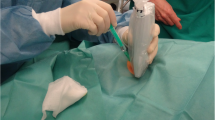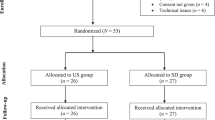Abstract
Ultrasound guidance is currently considered mandatory for central venous catherization. The only central venous access devices that do not require ultrasound for puncture and cannulation of the vein are the umbilical venous catheter (UVC) and the epicutaneo-cava catheters (ECC) in neonates. All other central lines used in neonates and in children (CICC, PICC, FICC, port) must be inserted by ultrasound guided cannulation of the vein.
Access this chapter
Tax calculation will be finalised at checkout
Purchases are for personal use only
Similar content being viewed by others
Bibliography
Barone G, D’Andrea V, Vento G, Pittiruti M. A Systematic ultrasound evaluation of the diameter of deep veins in the newborn: results and implications for clinical practice. Neonatology. 2019;115(4):335–340. https://doi.org/10.1159/000496848. Epub 2019 Mar 15. PMID: 30878998.
Barone G, Pittiruti M, Ancora G, Vento G, Tota F, D’Andrea V. Centrally inserted central catheters in preterm neonates with weight below 1500 g by ultrasound-guided access to the brachio-cephalic vein. J Vasc Access. 2021 May;22(3):344–352. https://doi.org/10.1177/1129729820940174. Epub 2020 Jul 10. PMID: 32648811.
Biasucci DG. Ultrasound based innovations for interventional procedures: the paradigmatic case of central venous access. Minerva Anestesiol. 2020;86(2):121–3.
Bodenham A, Babu S, Bennett J, et al. Association of anaesthetists of Great Britain and Ireland: safe vascular access 2016. Anaesthesia. 2016;71(5):573–85.
Bouaziz H, Zetlaoui PJ, Pierre S, et al. Guidelines on the use of ultrasound guidance for vascular access. Anaesth Crit Care Pain Med. 2015;34(1):65–9.
Breschan C, Graf G, Jost R, Stettner H, Feigl G, Goessler A, Neuwersch S, Koestenberger M, Likar R. Ultrasound-guided supraclavicular cannulation of the right brachiocephalic vein in small infants: a consecutive, prospective case series. Pediatr Anesth. 2015;25:943–9.
Breschan C, Graf G, Jost R, Stettner H, Feigl G, Neuwersch S, Stadik C, Koestenberger M, Likar R. A retrospective analysis of the clinical effectiveness of supraclavicular, ultrasound-guided brachiocephalic vein cannulations in preterm infants. Anesthesiol. 2018;128:38–43.
Breschan C, Platzer M, Jost R, Stettner H, Beyer AS, Feigl G, Likar R. Consecutive, prospective case series of a new method for ultrasound-guided supraclavicular approach to the brachiocephalic vein in children. Br J Anaesth. 2011;106:732–7.
Breschan C, Platzer M, Jost R, Stettner H, Feigl G, Likar R. Pediatr Anesth Ultrasound-guided supraclavicular cannulation of the brachiocephalic vein in infants: a retrospective analysis of a case series. Pediatr Anesth. 2012;22:1062–7.
Brescia F, Pittiruti M, Ostroff M, Biasucci DG. Rapid Femoral Vein Assessment (RaFeVA): A systematic protocol for ultrasound evaluation of the veins of the lower limb, so to optimize the insertion of femorally inserted central catheters. J Vasc Access. 2020 Oct 16. https://doi.org/10.1177/1129729820965063. Epub ahead of print. PMID: 33063616.
Bruzoni M, Slater BJ, Wall J, St Peter SD, Dutta S. A prospective randomized trial of ultrasound- vs landmark-guided central venous access in the pediatric population. J Am J Coll Surg. 2013;216:939–43.
Byon HJ, Lee GW, Lee JH, Park YH, Kim HS, Kim CS, Kim JT. Comparison between ultrasound-guided supraclavicular and infraclavicular approaches for subclavian venous catheterization in children—a randomized trial. Br J Anaesth. 2013;111:788–92.
Cellini M, Bergadano A, Crocoli A, Badino C, Carraro F, Sidro L, Botta D, Pancaldi A, Rossetti F, Pitta F, Cesaro S. Guidelines of the Italian Association of Pediatric Hematology and Oncology for the management of the central venous access devices in pediatric patients with onco-hematological disease. J Vasc Access. 2020 Nov 10. https://doi.org/10.1177/1129729820969309. Epub ahead of print. PMID: 33169648.
Crocoli A, Tornesello A, Pittiruti M, Barone A, Muggeo P, Inserra A, Molinari AC, Grillenzoni V, Durante V, Cicalese MP, Zanazzo GA, Cesaro S. Central venous access devices in pediatric malignancies: a position paper of Italian Association of Pediatric Hematology and Oncology. J Vasc Access. 2015 Mar-Apr;16(2):130–6. https://doi.org/10.5301/jva.5000314. Epub 2014 Oct 14. PMID: 25362978.
Emoli A, Cappuccio S, Marche B, et al. The ISP (Safe Insertion of PICCs) protocol: a bundle of 8 recommendations to minimize the complications related to the peripherally inserted central venous catheters (PICC). Assist Inferm Ric. 2014;33(2):82–9.
Froehlich CD, Rigby MR, Rosenberg ES, Li R, Roerig PL, Easley KA, Stockwell JA. Ultrasound-guided central venous catheter placement decreases complications and decreases placement attempts compared with the landmark technique in patients in a pediatric intensive care unit. Crit Care Med. 2009;37:1090–6.
Habas F, Baleine J, Milesi C, Combes C, Didelot MN, Romano-Bertrand S, Grau D, Parer S, Baud C, Cambonie G. Supraclavicular catheterization of the brachiocephalic vein: a way to prevent or reduce catheter maintenance-related complications in children. Europ J Pediatr. 2018;177:451–9.
Lamperti M, Biasucci DG, Disma N, Pittiruti M, Breschan C, Vailati D, Subert M, Traškaitė V, Macas A, Estebe JP, Fuzier R, Boselli E, Hopkins P. European Society of Anaesthesiology guidelines on peri-operative use of ultrasound-guided for vascular access (PERSEUS vascular access). Eur J Anaesthesiol. 2020 May;37(5):344–376. https://doi.org/10.1097/EJA.0000000000001180. Erratum in: Eur J Anaesthesiol. 2020 Jul;37(7):623. PMID: 32265391.
Leyvi G, Taylor DG, Reith E, Wasnick JD. Utility of ultrasound-guided central venous cannulation in pediatric surgical patients: a clinical series. Pediatr Anesth. 2005;15:953–8.
Montes-Tapia F, Rodríguez-Taméz A, Cura-Esquivel I, Barreto-Arroyo I, Hernández-Garduño A, Rodríguez-Balderrama I, Quero J, de la O-Cavazos M. Efficacy and safety of ultrasound-guided internal jugular vein catheterization in low birth weight newborn. J Pediatr Surg. 2016;51:1700–3.
Oulego-Erroz I, Muñoz-Lozón A, Alonso-Quintela P, Rodríguez-Nuñez A. Comparison of ultrasound guided brachiocephalic and internal jugular vein cannulation in critically ill children. J Crit Care. 2016;35:133–7.
Pirotte T, Veyckemans F. Ultrasound-guided subclavian vein cannulation in infants and children: a novel approach. Br J Anaesth. 2007;98:509–14.
Singh Y, Tissot C, Fraga MV, Yousef N, Cortes RG, Lopez J, Sanchez-de-Toledo J, Brierley J, Colunga JM, Raffaj D, Da Cruz E, Durand P, Kenderessy P, Lang HJ, Nishisaki A, Kneyber MC, Tissieres P, Conlon TW, De Luca D. International evidence-based guidelines on Point of Care Ultrasound (POCUS) for critically ill neonates and children issued by the POCUS Working Group of the European Society of Paediatric and Neonatal Intensive Care (ESPNIC). Crit Care. 2020 Feb 24;24(1):65. https://doi.org/10.1186/s13054-020-2787-9. PMID: 32093763; PMCID: PMC7041196.
Spagnuolo F, Vacchiano T. Ultrasound-guided cannulation of the brachiocephalic vein in newborns: A novel approach with a supraclavicular view for tip navigation and tip location. J Vasc Access. 2021 Mar 16. https://doi.org/10.1177/11297298211001159. Epub ahead of print. PMID: 33726580.
Spencer TR, Pittiruti M. Rapid Central Vein Assessment (RaCeVA): A systematic, standardized approach for ultrasound assessment before central venous catheterization. J Vasc Access. 2019;20(3):239–49.
Wu SY, Ling Q, Cao LH, et al. Real-time two-dimensional ultrasound guidance for central venous cannulation: a meta-analysis. Anesthesiology. 2013;118(2):361–75.
Author information
Authors and Affiliations
Editor information
Editors and Affiliations
Rights and permissions
Copyright information
© 2022 Springer Nature Switzerland AG
About this chapter
Cite this chapter
Disma, N.M., Pittiruti, M. (2022). Evidence Based Rationale for Ultrasound Guided Vascular Access in Children. In: Biasucci, D.G., Disma, N.M., Pittiruti, M. (eds) Vascular Access in Neonates and Children. Springer, Cham. https://doi.org/10.1007/978-3-030-94709-5_2
Download citation
DOI: https://doi.org/10.1007/978-3-030-94709-5_2
Published:
Publisher Name: Springer, Cham
Print ISBN: 978-3-030-94708-8
Online ISBN: 978-3-030-94709-5
eBook Packages: MedicineMedicine (R0)




